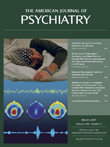Selecting an antipsychotic would be relatively easy if all patients responded similarly and if the most effective drug had the mildest side effects. Sadly, this is not the case. Each new publication of the findings from the Clinical Antipsychotic Trials of Intervention Effectiveness (CATIE) seems to provide an unexpected finding that becomes understandable through the rich database of this large, multicenter trial. The article by Stroup and his CATIE collaborators in this issue of the Journal documents how a group of patients with schizophrenia who are defined by a particular drug response differ from others in how they respond to a number of second-generation antipsychotics.
The patients in this study were individuals who were randomly assigned to perphenazine during phase 1 of CATIE and later discontinued that treatment for lack of efficacy, intolerability, or other reasons. These patients were then randomly assigned in phase 1B to a double-blind comparison of olanzapine, risperidone, and quetiapine. As in other CATIE trials, the effectiveness of each of these three drugs was measured by the time to drug discontinuation for any reason. The surprising finding is that the relative effectiveness of the three drugs differed substantially from that in phase 1. The time to discontinuation in phase 1B was longest for quetiapine, followed by olanzapine and then risperidone. In phase 1
(1), olanzapine had the effectiveness advantage, followed by risperidone and then quetiapine. In phase 2E
(2), which included patients who left phase 1 and who were willing to be randomly assigned to clozapine, clozapine had the advantage, followed by olanzapine, then quetiapine, and then risperidone. In phase 2T
(3), which included patients who left phase 1 because of intolerability of the assigned drugs or because they were unwilling to receive clozapine, the time to discontinuation was longest for risperidone, followed by olanzapine, and then quetiapine.
There were no meaningful differences among the demographic characteristics of the study groups. This suggests that there is information in the responses of these individuals to an antipsychotic and that this information can be helpful in predicting drug responses. Stroup and colleagues consider the possibility that a defining characteristic of the study group in phase 1B is their sensitivity to the side effects of perphenazine. For example, among the patients who discontinued perphenazine because of extrapyramidal side effects, five of six also discontinued risperidone. This suggests that patients who experience extrapyramidal symptoms while taking perphenazine may represent a group of individuals with a greater sensitivity to this side effect and that these individuals will experience varying amounts of extrapyramidal symptoms while taking risperidone. Similarly, this group of individuals may do well with quetiapine, an antipsychotic with minimal extrapyramidal side effects. However, there were no differences among the three agents in the scores on rating scales for extrapyramidal side effects, akathisia, or tardive dyskinesia. This inconsistency may tell us something about mild extrapyramidal symptoms and how difficult they can be to detect.
The observations of expert clinicians made nearly 30 years ago may be useful to today’s prescribers. At that time there was a concern that many clinicians were failing to appreciate that milder forms of akathisia and akinesia can be confused with depression and anxiety
(4,
5) . Van Putten observed that individuals with subjective akathisia may describe themselves as feeling anxious, uncomfortable, or irritable (6). These patients often do not demonstrate restless movements. He also observed that even a mild internal feeling of restlessness can be tormenting if a person experiences it all of his or her waking hours. Mild parkinsonism can also be difficult to detect. Experienced clinicians learned that they could detect mild rigidity by looking for a decrease in normal arm swing or a lack of expressive gestures. Individuals with mild parkinsonism may also feel slower.
It would not be surprising if the raters from CATIE were not sensitive to these mild manifestations. The raters did not rate any patients as having substantial increases in akathisia on the Barnes Akathisia Scale or extrapyramidal side effects on the Simpson-Angus Scale. There are suggestions that these vague symptoms could explain the differences among the drugs. The number of patients who discontinued treatment because of adverse effects was relatively small. The higher rate of discontinuation for olanzapine was probably a result of weight gain or sedation, which are relatively easy to detect. Mild extrapyramidal side effects may be embedded in the 32% of the risperidone patients whose discontinuation was classified as “patient decision.” These may have been individuals who disliked their drug but were unable to give an explanation that could be categorized as a side effect. If these observations are correct, it suggests that CATIE may have been relatively insensitive to milder forms of extrapyramidal side effects. This would not be surprising, since it is difficult to train raters in measuring mild akathisia and rigidity. It would also not be surprising if these side effects were also underestimated by the treating psychiatrists, since many busy clinicians are unlikely to systematically evaluate patients for extrapyramidal symptoms. The complexity is compounded by the difficulty schizophrenia patients may have in describing their subjective experiences from a medication.
These speculations about mild extrapyramidal side effects as an explanation for the differences among these drugs are only weakly supported by the study data. Nevertheless, they suggest an important principle for treating schizophrenia. Finding an antipsychotic regimen that patients can live with comfortably is an essential part of an effective management strategy. Each antipsychotic trial provides an opportunity to understand the factors—particularly the side effect sensitivity—that may affect how a patient feels while taking the next drug.

